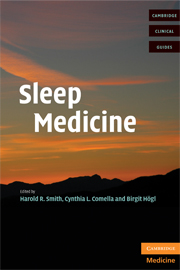Book contents
- Frontmatter
- Contents
- List of contributors
- Foreword
- SECTION 1 NORMAL SLEEP
- SECTION 2 SLEEP DISORDERS
- 3 Parasomnias
- 4 Circadian rhythm disorders
- 5 Excessive somnolence disorders
- 6 Insomnias
- 7 Restless legs syndrome and periodic limb movement disorder
- 8 Sleep apnea (central and obstructive)
- SECTION 3 SLEEP IN SPECIALTY AREAS
- Index
- References
5 - Excessive somnolence disorders
from SECTION 2 - SLEEP DISORDERS
Published online by Cambridge University Press: 08 August 2009
- Frontmatter
- Contents
- List of contributors
- Foreword
- SECTION 1 NORMAL SLEEP
- SECTION 2 SLEEP DISORDERS
- 3 Parasomnias
- 4 Circadian rhythm disorders
- 5 Excessive somnolence disorders
- 6 Insomnias
- 7 Restless legs syndrome and periodic limb movement disorder
- 8 Sleep apnea (central and obstructive)
- SECTION 3 SLEEP IN SPECIALTY AREAS
- Index
- References
Summary
Introduction
Excessive somnolence is characterized by the inability to stay awake during the desired wake period resulting in falling asleep in monotonous situations or developing unintended naps. Excessive somnolence can be a consequence of lifestyle, environmental and circadian influences, medical disorders, drugs or substances. When persisting for several weeks it is considered to be pathological, whereas it is a normal condition when occurring for a few days only, such as after sleep deprivation.
Excessive daytime sleepiness (EDS) is the term used for pathological states, defined as falling asleep in inappropriate situations and which cannot be controlled voluntarily. Between 4% and 9% of the general population are affected by EDS. The consequences on quality of life, performance, and concentration are dependent on the severity of EDS. The high socioeconomic costs of EDS have fostered efforts for early diagnosis and treatment. The underlying cause of EDS is determined by an assessment of multiple factors involved in the sleep/wake system. These may include environmental factors, lifestyle, genetics, inflammation, trauma, or tumor.
Sleep disturbances with EDS as the primary symptom have been classified by the International Classification of Sleep Disorders 2nd edition (ICSD-2) as “hypersomnias of central origin.” EDS may also be a prominent but not primary feature in other sleep disorders that are classified according to their main features, e.g., sleep-disordered breathing or sleep-related movement disorders. Since the discovery of REM sleep, enormous scientific progress has taken place in the understanding of sleep/wake disorders, giving rise to modern treatment options.
Keywords
- Type
- Chapter
- Information
- Sleep Medicine , pp. 78 - 96Publisher: Cambridge University PressPrint publication year: 2008
References
- 1
- Cited by



